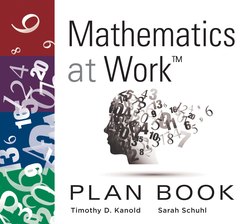Читать книгу Mathematics at Work™ Plan Book - Sarah Schuhl - Страница 6
На сайте Литреса книга снята с продажи.
ОглавлениеThe Mathematics at Work™ Plan Book
Mathematics at Work is built on the fundamental belief that every K–12 student can learn mathematics. To achieve this purpose, teachers and leaders of mathematics establish a reflect, refine, and act formative learning process for their students and themselves.
Mathematics at Work offers a comprehensive Professional Learning Communities (PLCs) at Work® approach to achieving mathematics success in K–12 classrooms. The Mathematics at Work framework empowers teachers, teacher teams, and mathematics education leaders to reflect on and refine current assessment, intervention, homework, and lesson designs based on high-quality, research-affirmed criteria.
The PLC at Work process is one of the best and most promising models a school or district can use to build a more equitable response for student learning. The work of collaborative teacher teams—especially in mathematics—when focused on the right assessment, instruction, and intervention criteria, will erase potential inequities in student learning. These collaborative team criteria lead to the sustained and substantive school-improvement process that characterizes PLCs at Work.
Since the mid-1990s, Richard DuFour, Robert Eaker, and Rebecca DuFour—the architects of the PLC at Work process—championed it as a model for school improvement. In a professional learning community, educators commit to working collaboratively in an ongoing process of collective inquiry and action research to achieve better results for the students they serve (DuFour, DuFour, Eaker, Many, & Mattos, 2016). The key to improving learning for students is continuous, job-embedded learning for educators as a type of collective teacher efficacy.
Most plan books guide the individual classroom teacher in instructional decisions. They focus on, “What will I teach, when will I teach it, and how will I teach it?” The Mathematics at Work Plan Book is unique because it not only assists the individual teacher in unit-by-unit planning, but it also guides the collaborative team processes essential to schools that operate as PLCs. In this plan book, and throughout the Every Student Can Learn Mathematics series, we emphasize the concept of team action. Because some teachers may be the only members of a grade-level or mathematics course, we recommend you work with a colleague in a grade level or course above or below your own as a vertical team. Or, work with other job-alike teachers across a geographical region as technology allows.
Collaborative teams are the engines that drive the PLC at Work process. Most importantly, this plan book calls on you to develop your self-confidence and sense of collective efficacy to go far beyond the traditional questions of teaching, arriving at a relentless collaborative focus on learning—for both students and adults.
Your team can refer to the books in the Every Student Can Learn Mathematics series to help with your planning efforts: Mathematics Coaching and Collaboration in a PLC at Work (Kanold, Toncheff, Larson, Barnes, Kanold-McIntyre, & Schuhl, 2018), Mathematics Assessment and Intervention in a PLC at Work (Kanold, Schuhl, Larson, Barnes, Kanold-McIntyre, & Toncheff, 2018), Mathematics Homework and Grading in a PLC at Work (Kanold, Barnes, Larson, Kanold-McIntyre, Schuhl, & Toncheff, 2018), and Mathematics Instruction and Tasks in a PLC at Work (Kanold, Kanold-McIntyre, Larson, Barnes, Schuhl, & Toncheff, 2018).
The first part of the Mathematics at Work Plan Book contains an overview of the big ideas that shape Mathematics at Work, cultural shifts that you can expect in a PLC at Work, and keys to building high-performing collaborative teams. It also includes tools to help you work with your team more effectively as well as protocols for evaluating current assessment, homework, instruction, and intervention routines. You can also visit go.SolutionTree.com/MathematicsatWork to access additional online resources. The second part provides unit-planning charts to help you work as a team to determine the mathematics units for the school year. The third part includes thirty-eight weeks of unit-planning pages with text and activities to inform, inspire, and challenge you and your teammates as you take the Mathematics at Work journey. We designed these pages to help inform the nature of your collaborative work together throughout the year. You’ll also learn from other schools and districts that have embarked on the same journey. The fourth part provides references and resources for further study.
